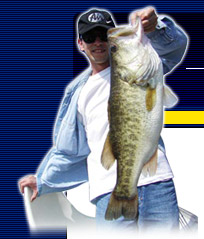| |
 Tackle Tips for Lake El Salto.
Tackle Tips for Lake El Salto.
Lake El Salto is about as close to the mythical "dream bass lake" as you'll ever experience. This lake affords anglers the opportunity to use a variety of lures and fishing techniques.
If topwater fishing is your forte, you'll find excellent surface action during most of the fishing season at El Salto. And many of the fish that explode on surface lures are true trophy bass. If you're a spinnerbait afficionado, there are plenty of prime pieces of cover for you to probe on this bass factory. Perhaps deep crankbaiting is more to your liking. You'll find no better crankbait fishery in the world than El Salto Lake. Maybe it's bumping a worm across a point that's your preferred method for tempting lunker bass. El Salto has been described as a worm angler's dream lake. So, as you can clearly see, Lake El Salto will offer you tremendous opportunities for you to practice your tried and true fishing techniques, as well as develop new techniques, because one thing is for certain - you'll have plenty of rod bending and drag screeching action!
Topwater Techniques
The visual image of enticing a huge bass to take a lure on the surface is one of the most exciting and challenging methods of fishing on El Salto. However, whether it's Lake El Salto in Mexico you are fishing, or a bass lake in the states, the fact is that bass do not feed on the surface all day long. Anglers, therefore, must recognize when conditions are favorable to practice this method of fishing. In general, early morning hours, late afternoon hours and during periods of cloud cover find bass most susceptible to a topwater assault at El Salto. Typically, when the sun is high overhead and the temperature is hot and sultry, El Salto bass prefer the comfort of deeper water, so it would be foolish to fish topwater baits under these conditions when other patterns would be so much more productive.
Although a bass might hit a topwater lure in just about any location you cast it, there are certain high percentage areas that will increase your odds of tempting more bass on El Salto. Concentrate your efforts in windblown pockets and coves, standing timber, shoreline brush, points and stumps. Bass tend to use cover and structure (such as brush, stumps, points or standing timber) as ambush points. It is always wise to either cast as close to these forms of cover and structure as possible, or, alternatively, actually cast beyond them and work the topwater baits right up to them, almost attempting to glance the cover with your baits.
In some instances, the bass on El Salto prefer a slow, deliberate retrieve of topwater lures, while other moments find them desiring a lure that is aggressively worked across the surface. Let the fish tell you how to present your baits. The guides will also be helpful in this regard as well.
Buzzbaits
 |
Buzzbaits are basically a lure comprised of a durable wire frame and plastic or rubber skirted material. It possesses a propeller that rotates around the wire shaft and creates much surface commotion. Bass experts simply cannot equate a buzzbait to anything in nature, however they all agree that it is a bait that tends to attract a big fish. Buzzbaits can be worked very fast and aggressively across the surface or, alternatively, you can slow the bait |
down during your retrieve and raise your rod tip to work them just fast enough to keep the prop turning and the bait on the surface. El Salto bass will take them either way, so use varying retrieves until the bass tell you how they want the buzzbait presented. |
 using line ranging from 17 to 20 lbs.
using line ranging from 17 to 20 lbs. |
Typically, anglers will use a rod from 6 to 6-1/2 feet long and of medium/heavy action. A slightly flexible tip will allow the bass to engulf the buzzbait before your rapid hook set causes you to pull it out of its mouth. A fast retrieve reel will allow you to work them more effectively. Because you will typically be working these baits around thicker cover and because bass tend to hit them very aggressively, consider When possible, try to cast the buzzbait beyond the cover, such as a stump or brushpile, then work the bait up to the cover |
and actually try to glance off the cover with the bait. This caroming action off the cover will often trigger a strike. When a fish strikes your bait, try to resist the tendency to immediately set the hook. Although easier said than done, wait to feel the weight of the fish before setting the hook. Work the bait all the way back to the boat as, in many cases, a fish may follow it from the cover and then strike it just feet from the boat. If you are generating strikes, but missing fish, consider adding a trailer or "stinger" hook that extends out beyond the regular hook. In some instances, the buzzbait is made more enticing by adding a large grub, plastic twin-tail or lizard as a trailer. |
Walking Baits

|
Many believe that walking baits are the most underutilized baits in the arsenal of the bass angler. These baits typically require the most work (not strength) in terms of getting the best action, and anglers, typically novice ones, shy away from them because of this. These types of lures are extremely effective when you impart the famous "walk the dog" retrieve, basically a coordinated series of wrist snaps that cause the bait to zigzag across the water and resembles an injured or disoriented baitfish . |
The gold standard of walking baits is the Zara Spook, although others are very productive as well, such as the Gilmore Oddball and MirroLure Top Dog. The key to these lures is that they emit a lot of action, but stay in the strike zone for long periods of time. Cast these lures beyond the target or over a point and "walk the dog" so that you allow the lure to almost come in contact with cover. |
Poppers
 |
El Salto' bass have a strong affinity to slam popping plugs. These concave mouthed lures bite the water and then spit or push it forward, creating a tantalizing sound and site similar to bass feeding on the surface. These lures, such as the Rebel Pop-R, Storm Chug Bug, Gilmore Hoodler, Mann's Chug-N-Spit and Yo-Zuri Popper, come in an array of sizes and colors and you will need to experiment to see which they prefer. |
| These baits can be worked very slow and deliberate, or can be worked fast and erratic. As with all baits, let the fish tell you if they want it fast or deliberate. Again, these baits are most effective when casted beyond cover or structure and retrieved very close to the cover. |
Propeller Ripping Baits
 |
These plastic or wooden lures have rotating propellers that allow you to rip the baits across the surface and displace water and create visible and audible commotion. These baits are best used when the fish are really aggressive and attacking topwater lures with a fury. Some of the very best on El Salto include the Gilmore Jumper, Gilmore Go Getter, Hedden Baby Torpedo, Smithwick Devil's Horse and ½-ounce Luhr-Jensen Wood Chopper. When bass do not seem to be aggressively chasing baits, these prop lures are best worked slow and deliberate, allowing a pause between each twitch of the wrist to move these baits. |
When the fish are chasing bait, you can work them more aggressively with a faster ripping cadence. In some instances, props on the nose and tail end of the baits produce better, while other situations finding that bass only prefer baits with props in their tail section. |
Soft Plastic Jerkbaits and Worms
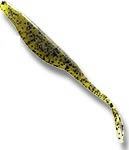 |
Popular baits like the Lunker City Slug-Go, Bass Assassin Shad Assassin and Zoom Fluke, as well as other variations of this lure, can best be described as soft plastic jerk baits. These baits are most noted for their ability to entice shallow oriented bass, or those feeding or schooling near the surface."Baits like the Slug-Go are so effective because of their unpredictable or random action," points out professional guide Dave Masterson, a frequent visitor to El Salto."This is one of the primary reasons why they consistently catch fish when other lures fail to do so. Most of the wood or hard plastic baits we use are very mechanical in their action, certainly the opposite of the hapless, erratic action that one observes of an injured or fleeing baitfish. |
When bass are actively feeding, just about any lure will tempt them. However, when they are negative or neutral, I want a bait that offers a more realistic action. That's when I turn to a soft plastic jerk bait like the Slug-Go.
Very few baits come in such an outrageous array of colors as the soft plastic jerk baits. These bright colors do not appear to repulse fish and serve the purpose of allowing anglers to carefully observe the baits during a retrieve. In clear water, many anglers, however, do prefer natural shad type colors. In off colored water, anglers might want to consider a bright color such as merthiolate, hot pink or highway stripe yellow.
"I believe that the key to the success of these soft plastic jerk baits," Jeff Peterson "is that they can be worked across the surface, or allowed to descend or suspend a foot or two below the surface, a depth where may shallow water oriented bass tend to cruise, especially during the spring and fall months. "On many occasions, I have observed bass honing in on a floating hard plastic or wood topwater bait, only to nudge it, but never aggressively strike it. For some reason, bass can be hesitant about breaking the surface to strike a floating bait. When working the soft plastic jerk baits you can alter your speed or retrieval depth to reflect the mood of the fish."
The most common retrieve is to keep the rod tip pointing towards the water. This serves to keep the line out of the wind and allows you to work the bait unimpeded by slack line. Use six inch sharp snaps of the wrists to retrieve the bait. When the fish are aggressively attacking the bait on or near the surface, you'll be astonished of how many strikes you'll observe, so keep the bait within site during the entire retrieve.
"Initially, try letting the baits flip across the surface like a wounded shad," says Jeff Peterson, "especially if you are fishing a school of feeding bass or shad fleeing at the surface. If the fish are hesitant about taking the bait on the surface, work it about one to three feet deep, a depth where you can still visualize the bait. I find this to be the most effective retrieve and depth range. I don't do anything fancy, I just snap the wrist and pause, snap the wrist and pause. The only real alteration is the speed in which I retrieve the bait. Sometimes they want to chase it, other times call for you to work it slowly, literally tantalizing the fish with the erratic action."
When initially learning how to fish floating unweighted worms, such as the Zoom Trick Worm, it probably is best to rig it Texas style. As one becomes proficient with the floating worm, you may want to experiment with various rigging modifications, including fishing it wacky style by hooking it through the egg sac or center of the worm. |
 |
"I always recommend fishing the floating worm on spinning gear," says Jeff Peterson. "It will afford you greater distances on the cast, so you can avoid spooking shallow fish. According to Peterson, probably the number one problem novice anglers have when working floating worms is that they set the hook as soon a they feel the strike or see the fish take the baits. He advises hesitating a few seconds to allow the fish to inhale the bait and start swimming away with it. |
If the fish are deeper, you may elect to fish the stern weighted hooks from Mustad or the Lunker City insert weights. The inserts are either pierced across the body of the bait and then clipped so that no portion of the insert remains outside the baits or inserted near the bend of the hook to make them stern weighted. |
Subsurface Techniques
Plastic Worms and Lizards
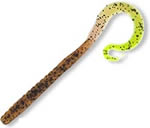 |
Probably no other lure has been responsible for landing as many Mexican bass as the plastic worm. It is probably so productive because it can probe the mid to deep water haunts of El Salto' bass more efficiently than just about any other lure. The most popular and productive way to rig worms for the bass of El Salto is via the Texas rig method. The Texas rig allows you to fish the worm in a weedless manner, as the hook point is not exposed to snag into various forms of cover, but rather is buried into the body of the worm. |
When fishing shallow water and thicker cover, worms in the five to seven inch category are most effective, as they will not tend to get hung up in the cover as longer versions. When fishing shallow water, consider a pegged slip sinker that is between 1/8 and ¼-ounce in weight. Pegging will not allow the worm to be disassociated from the weight and will make it more streamlined when going through cover like brush or trees.
One of the best methods for catching a true El Salto trophy bass is to fish plastic worms within and across deep structure, such as humps, points, old road beds and submerged standing timber. For this deep structure approach, consider using plastic worms from 7 to 11 inches in length and up the weight of your slip sinker to between ¼ and ½ ounce so that you can effectively feel the worm and weight carom across the bottom. |
 |
Plastic lizard are also very appealing to El Salto' bass. The lizard offers the same tantalizing, lifelike action of a plastic worm, however might have a slightly larger profile. The lizard is rigged in the same manner as the plastic worm. |
When worm fishing, consider rods from 6-1/2 to 7 feet in length. Rely on line weight between 14 and 20 lbs. Keep in mind that deep El Salto bass have an affinity to head for cover once hooked on a plastic worm, so you've got to really horse them once hooked. The heavier line will allow you to do so more efficiently. Productive colors of worms and lizards on El Salto include: pumpkinseed, pumpkinseed with chartreuse tail, Tequila Sunrise, grape, red shad and blue shad. Of course, always consider fishing the style and color worms you have confidence in as the bass on El Salto are not very finicky. |
Crankbaits
Crankbaits are basically wood or hard plastic fish imitating treble hook laden lures. They are usually categorized into three depth ranges - shallow, medium and deep. Typically, shallow running crankbaits possess either no lip or a small one. The deeper running lures tend to be heavier, with elongated lips. Crankbaits are a must for any angler visiting Huities, especially if he or she is in search of a trophy bass.
Lipless Crankbaits
 |
For simply fancasting the water and attempting to locate fish, few lures will produce as well as the lipless crankbait, basically a moulded plastic crankbait that has an internal sound chamber with shot or BB's to produce an attracting rattling noise on the retrieve.
These baits produce a tight wobble and can be casted great distances. |
Although anglers have had very good success using a yo-yo (rise-and-fall) retrieve, the majority of these anglers cast these lures and retrieve them straight back to the boat using a medium to fast retrieve. Very effective lipless crankbaits include the Bill Lewis Rat-L-Trap, Cordell Hot Spot and Rapala Rattlin' Rap. The ½-ounce size range seems to work best on El Salto. |
Lipped Crankbaits
 |
You should rely on a lipped crankbait when you want to get lures to deeper water, say from 6 to 20 feet or when you want the lure to carom off submerged objects with less chance of getting hung up. Cast shallow running crankbaits to banks, shallow points and ridges. |
Don't be afraid to cast near cover, but not directly into it. Bring an array of shallow oriented baits such as the Rapala Shad Rap, Bill Dance Fat Free Shad in the 2 inch, 3/8-ounce size, Bomber model 6A and 7A, Bill Norman Deep Little N and Rapala Fat Raps. |
 |
Without question, the most popular, as well as most productive, medium to deep running crankbait on El Salto is the Bill Dance Fat Free Shad. Although El Salto' bass will take other large crankbait offerings, the Fat Free Shad continues to outcatch anything else. |
Two must sizes of this bait to bring on your trip to El Salto are the 2-1/2 inch, ½-ounce model and the 3-inch, ¾-ounce model. Must colors include the threadfin shad, pearl white, pearl body with red back, firetiger, citrus shad and blue shad.Fish these baits on ridges, bars, points and humps. A medium to fast retrieve seems to be the most productive method to entice El Salto' bass. El Salto bass tend to school, so if you land a lunker fish on a deep diving crankbait, keep these fish "hot" and active by continuing to saturate the water with these baits. These baits will trigger a bite unlike any other lure on El Salto. |
Spinnerbaits
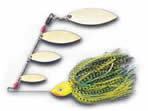 |
Spinnerbaits are extremely effective lures, as they can be fished in a variety of ways. They basically resemble a safety pin in design. A lead head of varying weight is combined with a wire framework, sharp hook and one or more flashing spinner blades which may range from an oval shape to a long slender willowleaf shape. A soft-rubber, plastic, silicone or "lumaflex" skirt is added to cover the hook and to add color and bulk to entice bass.A few basic rules apply when fishing spinnerbaits, however these are not set in stone and a savvy angler will let the fish dictate what bait to use and not simply follow the guidelines set down by other anglers. |
In general, however, you should consider a white or baitfish colored skirted spinnerbait in clear water. In off colored or dingy water, consider a chartreuse or dark colored skirted spinnerbait. If you are fishing in clear water, the flash of a spinnerbait is more important then when you are fishing in dingy water (where sound and vibration might be more important), so consider a bait that offers willowleaf blades. These blades are known for their flash. In off-colored water, consider a Colorado or Indiana blade, as they give off more vibration. In clearer water, you should initially try chrome, gold or white colored spinnerbait blades, while in off-colored water, consider chartreuse, gold, black or copper colored blades. |
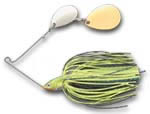 |
Because El Salto is such a deep lake, consider a heavier headed spinnerbait (at least a half ounce), so that you can get the baits down quicker to cover that might be in 3 to 5 feet of water. You don't necessarily have to use a super-large bodied bait, just a heavier head. Bring a selection of spinnerbaits ranging from ¼ to ¾ ounces and with a variety of colored skirts and blades and with a good selection of the various shapes of blades. Experiment with single bladed spinnerbaits as well as tandem bladed baits. |
When fishing shallow water cover, cast past the cover and work the spinnerbait up to the cover and bump it before continuing the retrieve. You may want to also consider "killing" the bait after it bumps the objects before continuing the retrieve. In deeper water, consider using single bladed baits and use a yo-yo or rise and fall retrieve or a slow crawl retrieve. If the fish are not holding tight to shallow water cover, consider backing out and working the spinnerbait around submerged cover in 4 to 8 feet of water. The fish will let you now just how fast to retrieve these baits and whether they want a steady or stop and start retrieve.
Consider using a rod that has a flexible tip, as too many anglers using stout worm type rods and do not give the fish a chance to inhale the bait before setting the hook and pulling it away from them. Typically, with spinnerbaits, you should rely on line ranging from 14 to 25 lb test on El Salto. |
|
|
